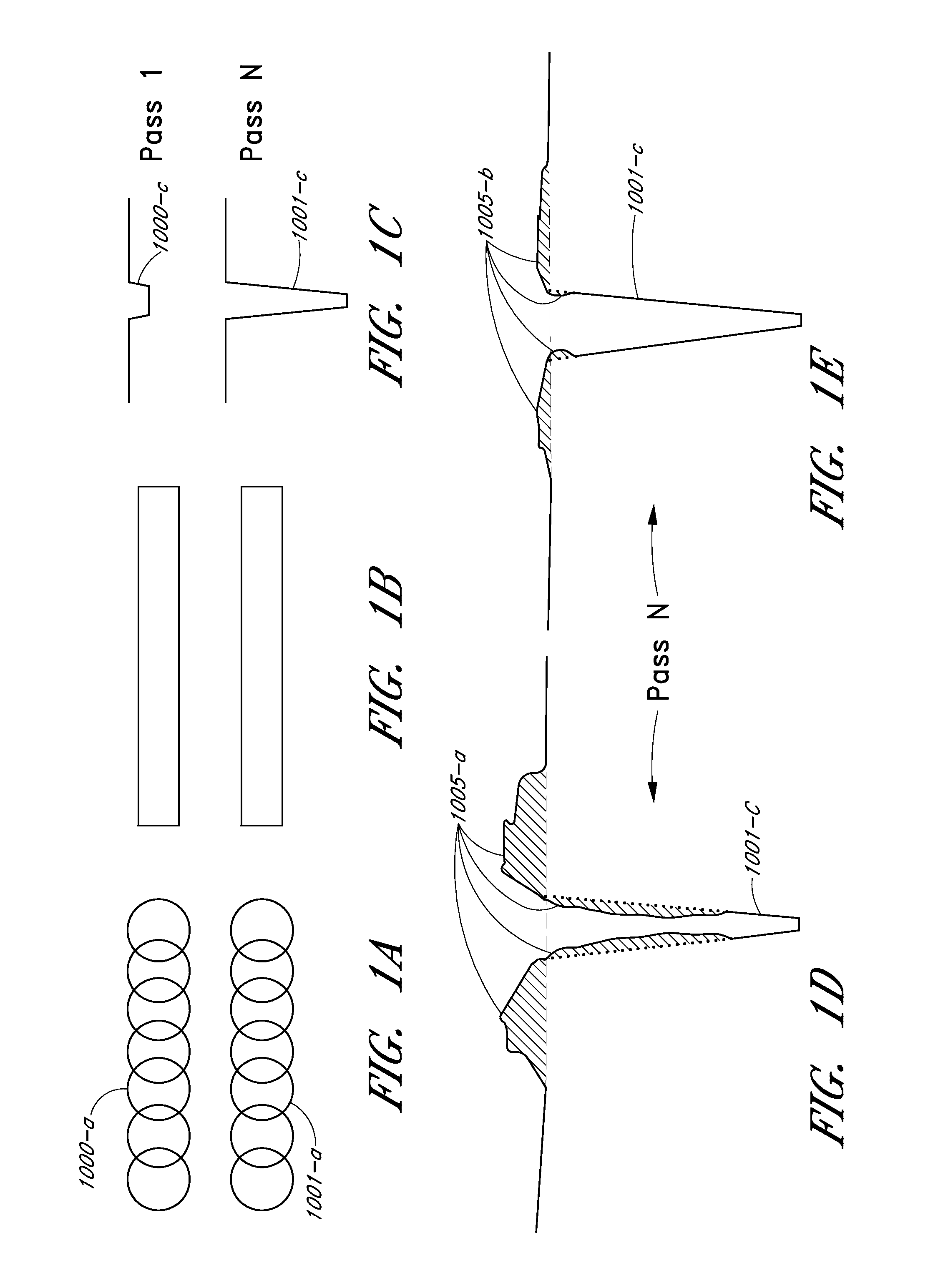Laser-based material processing methods and systems
a laser and material processing technology, applied in the direction of manufacturing tools, metal working equipment, welding/soldering/cutting articles, etc., can solve the problems of increasing the complexity of the device, the environmental cost of chemical processing, and the device size reduction, so as to efficiently remove a substantial depthwise portion of the material
- Summary
- Abstract
- Description
- Claims
- Application Information
AI Technical Summary
Benefits of technology
Problems solved by technology
Method used
Image
Examples
example experiments
with Longer Pulse Durations
[0186]Experimental data was obtained using longer pulse widths. FIGS. 13A-1-13A-3 are SEM images showing results obtained with pulses having a pulse width of about 200 ps. Repetition rates of 200 kHz, 350 kHz, and 500 kHz were used at various scan speeds. In these experiments, the pulse compressor was detuned so as to produce pulse widths of about 200 ps and pulse energy of 20 μJ. The experimental results were also surprising. The trend of reducing a quantity of unwanted material continued in these experiments with longer pulse durations. However, in comparison to the experiments with ultrashort pulses, better feature quality, trench shape, and repeatability were obtained with ultrashort pulses.
[0187]FIGS. 13A-4-13A-5 are plots corresponding to the SEM images of FIGS. 13A-1-13A-3. The measurement method for determining area was modified as disclosed above (e.g., polygons were used). The plots in FIGS. 13A-4-13A-5 suggest that predictability and repeatabili...
experiment 1
[0230]A particularly encouraging result was obtained with processing of GaN on Copper. The result was obtained with parameters that may be well suited for cutting several bare wafers: 10 μJ, 500 kHz, approximately 7 m / sec, with about 1000-1500 passes, and a spot size of about 30-40 μm (1 / e2 diameter). FIG. 15A is an SEM image showing a high quality cut 1505 with little or no debris. FIG. 15B is a side view of the cut. Various materials are discernible in the image, including overlying material 1510, GaN material 1515, and inner layer(s) 1520. No attempts were made to clean the sample after laser processing.
experiment 2
[0231]A microelectronic circuit having an overlying passivation layer, multiple alternating layers of copper and low-k dielectric, and a silicon substrate was laser scribed. Processing was first carried out with 100 passes, about 7 msec scan speed, 10 μJ pulse energy, and 500 kHz. FIGS. 15C and 15D are SEM images schematically illustrating incomplete cuts of a copper pad and some low-k delamination, respectively. The laser parameters resulted in removal of the passivation layer, but only partial removal of the copper layer. The region of the cut also shows noticeable surface texturing. The low-k dielectric removal was incomplete with evidence of delamination and cracking 1530. In some cases, a reduction in scan speed, and a corresponding increase in spatial overlap of the pulses, may improve copper removal.
PUM
| Property | Measurement | Unit |
|---|---|---|
| Fraction | aaaaa | aaaaa |
| Time | aaaaa | aaaaa |
| Time | aaaaa | aaaaa |
Abstract
Description
Claims
Application Information
 Login to View More
Login to View More - R&D
- Intellectual Property
- Life Sciences
- Materials
- Tech Scout
- Unparalleled Data Quality
- Higher Quality Content
- 60% Fewer Hallucinations
Browse by: Latest US Patents, China's latest patents, Technical Efficacy Thesaurus, Application Domain, Technology Topic, Popular Technical Reports.
© 2025 PatSnap. All rights reserved.Legal|Privacy policy|Modern Slavery Act Transparency Statement|Sitemap|About US| Contact US: help@patsnap.com



